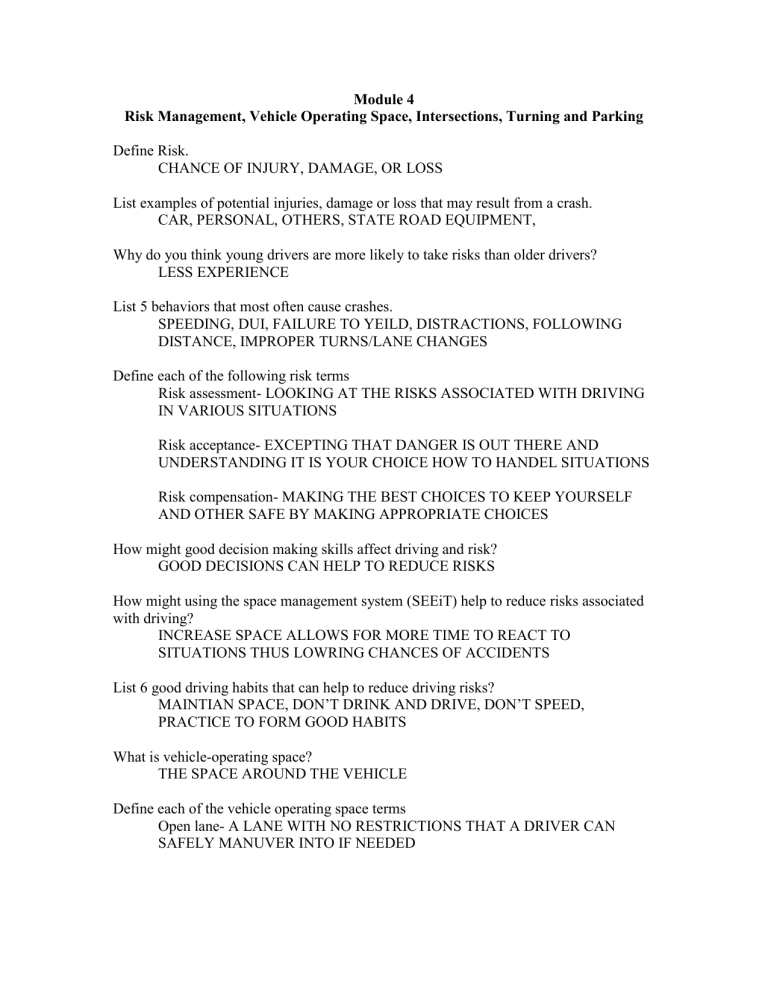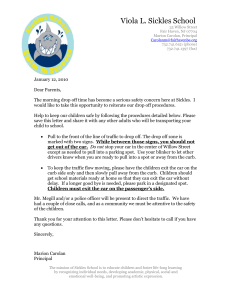
Module 4 Risk Management, Vehicle Operating Space, Intersections, Turning and Parking Define Risk. CHANCE OF INJURY, DAMAGE, OR LOSS List examples of potential injuries, damage or loss that may result from a crash. CAR, PERSONAL, OTHERS, STATE ROAD EQUIPMENT, Why do you think young drivers are more likely to take risks than older drivers? LESS EXPERIENCE List 5 behaviors that most often cause crashes. SPEEDING, DUI, FAILURE TO YEILD, DISTRACTIONS, FOLLOWING DISTANCE, IMPROPER TURNS/LANE CHANGES Define each of the following risk terms Risk assessment- LOOKING AT THE RISKS ASSOCIATED WITH DRIVING IN VARIOUS SITUATIONS Risk acceptance- EXCEPTING THAT DANGER IS OUT THERE AND UNDERSTANDING IT IS YOUR CHOICE HOW TO HANDEL SITUATIONS Risk compensation- MAKING THE BEST CHOICES TO KEEP YOURSELF AND OTHER SAFE BY MAKING APPROPRIATE CHOICES How might good decision making skills affect driving and risk? GOOD DECISIONS CAN HELP TO REDUCE RISKS How might using the space management system (SEEiT) help to reduce risks associated with driving? INCREASE SPACE ALLOWS FOR MORE TIME TO REACT TO SITUATIONS THUS LOWRING CHANCES OF ACCIDENTS List 6 good driving habits that can help to reduce driving risks? MAINTIAN SPACE, DON’T DRINK AND DRIVE, DON’T SPEED, PRACTICE TO FORM GOOD HABITS What is vehicle-operating space? THE SPACE AROUND THE VEHICLE Define each of the vehicle operating space terms Open lane- A LANE WITH NO RESTRICTIONS THAT A DRIVER CAN SAFELY MANUVER INTO IF NEEDED Closed Lane- A LANE THAT COULD CHANGE FROM CLEAR TO NOT CLEAR OR THE OPPOSITE Changing lane- A LANE THAT HAS A RESTRICTION- YOU CAN NOT MOVE INTO THESE LANES Put an X on all open lanes X X X X Put an X on all closed lanes X X X X Decision Making- Draw arrows to indicate how you would handle each situation (you are the ) 14. The vehicle in front of you suddenly brakes. Draw and explain what you should do. 15. The vehicle behind you is approaching rapidly. What should you do to reduce your risks. Draw arrows to indicate your decision and explain. 16. You need to exit the highway. Explain what you would do in this situation. (hint: the next exit is 5 miles up the road) Exit TAKE THE NEXT EXIT AND TURN AROUND THAT WAY- EXIT NUMBERS ARE THE SAME IN EITEHR DIRECTION 17. Draw arrows to indicate how you would handle the following. (hint: there are no other cars on the road) Car accident with emergency vehicle/police/fire/ ambulance Draw and describe how to perform a right turn at an intersection SIGNAL, STOP, CHECK TRAFFIC, TARGET PATH, GO WHEN THE WAY IS CLEAR, MOVE INTO POSITON 1 Draw and describe how to perform a left hand turn at an intersection. SIGNAL, STOP, CHECK TRAFFIC, TARGET PATH, GO WHEN THE WAY IS CLEAR, MOVE INTO POSITON 1 Draw and explain the following techniques: Two Point Turns- forward Two Point Turns- backward PULL INTO AREA- BACK OUT IN OPPOSITE DIRECTION – PULL FORWARD Three Point Turns BACK INTO AREA- PULL OUT IN OPPOSITE DIRECTION– Angle Parking MOVE TO MAKE U TURNREVERSE- PULL FORWARD TO FINISH LINE UP SIDE MIRROR WITH 1ST WHITE LINE OF THE SPACEPULL IN FORWARD Perpendicular Parking Parallel Parking LINE UP SIDE MIRROR WITH 1ST WHITE LINE OF THE SPACEPULL IN FORWARD Down Hill TURN WHEELS TOWARDS CURB Up Hill no curb TURN WHEELS TOWARDS CURB MIRROR TO MIRROR- REAR BUMPER TO REAR BUMPER-CUT INTO SPOT- MIRROR TO REAR BUMPER- CUT IN OPPOSITE DIRECTION- PULL FORWARD TO STRAIGHTEN Up Hill with a curb TURN AWAY FROM CURB



